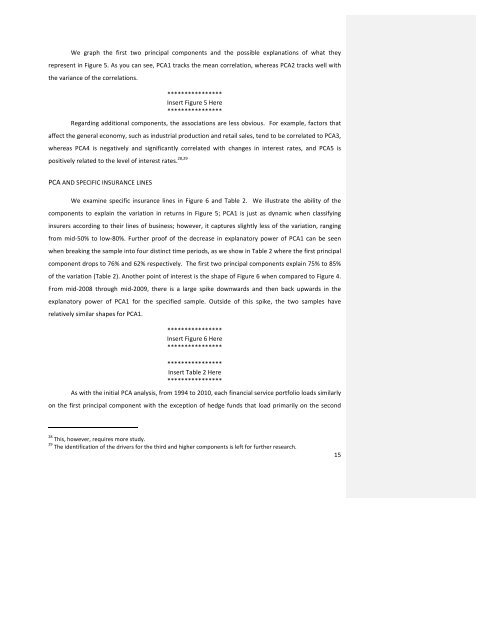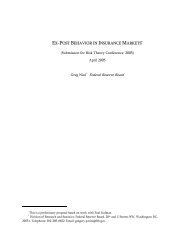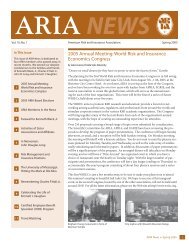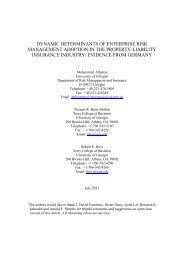Insurance and Interconnectedness in the Financial Services Industry
Insurance and Interconnectedness in the Financial Services Industry
Insurance and Interconnectedness in the Financial Services Industry
You also want an ePaper? Increase the reach of your titles
YUMPU automatically turns print PDFs into web optimized ePapers that Google loves.
We graph <strong>the</strong> first two pr<strong>in</strong>cipal components <strong>and</strong> <strong>the</strong> possible explanations of what <strong>the</strong>y<br />
represent <strong>in</strong> Figure 5. As you can see, PCA1 tracks <strong>the</strong> mean correlation, whereas PCA2 tracks well with<br />
<strong>the</strong> variance of <strong>the</strong> correlations.<br />
****************<br />
Insert Figure 5 Here<br />
****************<br />
Regard<strong>in</strong>g additional components, <strong>the</strong> associations are less obvious. For example, factors that<br />
affect <strong>the</strong> general economy, such as <strong>in</strong>dustrial production <strong>and</strong> retail sales, tend to be correlated to PCA3,<br />
whereas PCA4 is negatively <strong>and</strong> significantly correlated with changes <strong>in</strong> <strong>in</strong>terest rates, <strong>and</strong> PCA5 is<br />
positively related to <strong>the</strong> level of <strong>in</strong>terest rates. 28,29<br />
PCA AND SPECIFIC INSURANCE LINES<br />
We exam<strong>in</strong>e specific <strong>in</strong>surance l<strong>in</strong>es <strong>in</strong> Figure 6 <strong>and</strong> Table 2. We illustrate <strong>the</strong> ability of <strong>the</strong><br />
components to expla<strong>in</strong> <strong>the</strong> variation <strong>in</strong> returns <strong>in</strong> Figure 5; PCA1 is just as dynamic when classify<strong>in</strong>g<br />
<strong>in</strong>surers accord<strong>in</strong>g to <strong>the</strong>ir l<strong>in</strong>es of bus<strong>in</strong>ess; however, it captures slightly less of <strong>the</strong> variation, rang<strong>in</strong>g<br />
from mid-‐50% to low-‐80%. Fur<strong>the</strong>r proof of <strong>the</strong> decrease <strong>in</strong> explanatory power of PCA1 can be seen<br />
when break<strong>in</strong>g <strong>the</strong> sample <strong>in</strong>to four dist<strong>in</strong>ct time periods, as we show <strong>in</strong> Table 2 where <strong>the</strong> first pr<strong>in</strong>cipal<br />
component drops to 76% <strong>and</strong> 62% respectively. The first two pr<strong>in</strong>cipal components expla<strong>in</strong> 75% to 85%<br />
of <strong>the</strong> variation (Table 2). Ano<strong>the</strong>r po<strong>in</strong>t of <strong>in</strong>terest is <strong>the</strong> shape of Figure 6 when compared to Figure 4.<br />
From mid-‐2008 through mid-‐2009, <strong>the</strong>re is a large spike downwards <strong>and</strong> <strong>the</strong>n back upwards <strong>in</strong> <strong>the</strong><br />
explanatory power of PCA1 for <strong>the</strong> specified sample. Outside of this spike, <strong>the</strong> two samples have<br />
relatively similar shapes for PCA1.<br />
****************<br />
Insert Figure 6 Here<br />
****************<br />
****************<br />
Insert Table 2 Here<br />
****************<br />
As with <strong>the</strong> <strong>in</strong>itial PCA analysis, from 1994 to 2010, each f<strong>in</strong>ancial service portfolio loads similarly<br />
on <strong>the</strong> first pr<strong>in</strong>cipal component with <strong>the</strong> exception of hedge funds that load primarily on <strong>the</strong> second<br />
28 This, however, requires more study.<br />
29 The identification of <strong>the</strong> drivers for <strong>the</strong> third <strong>and</strong> higher components is left for fur<strong>the</strong>r research.<br />
15






